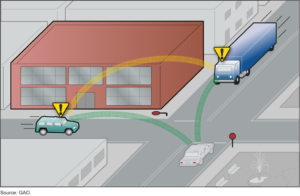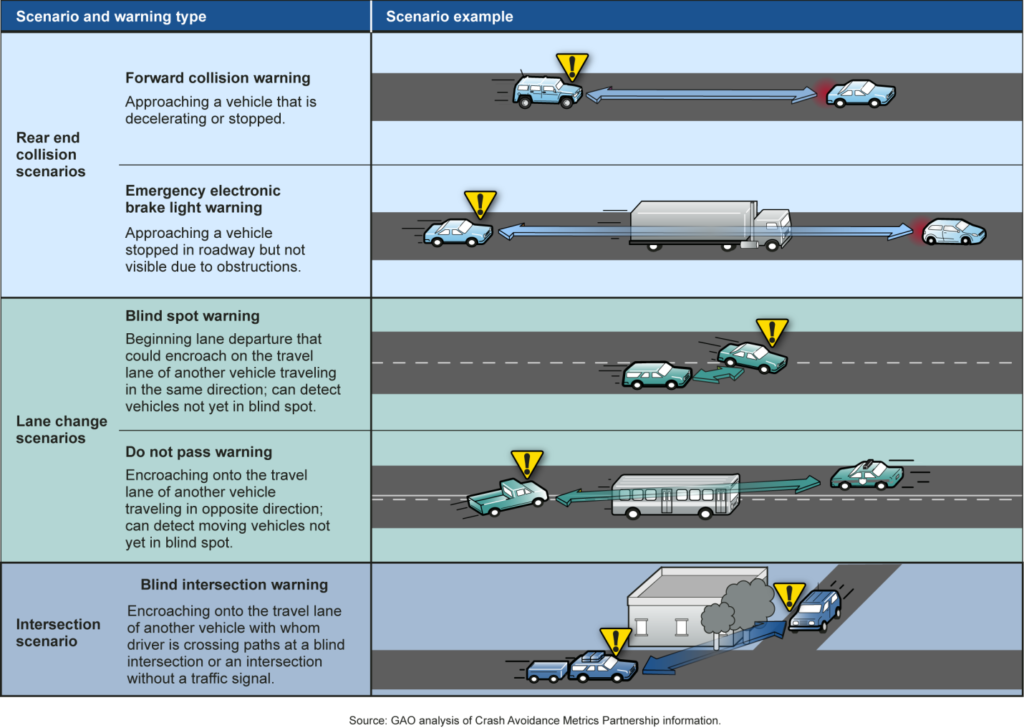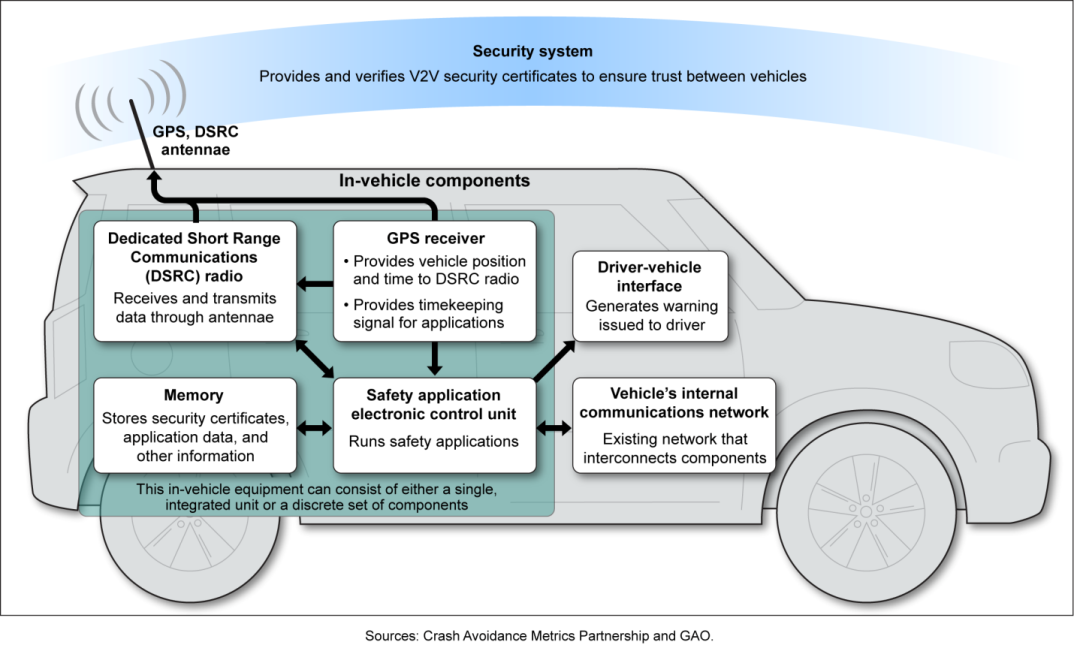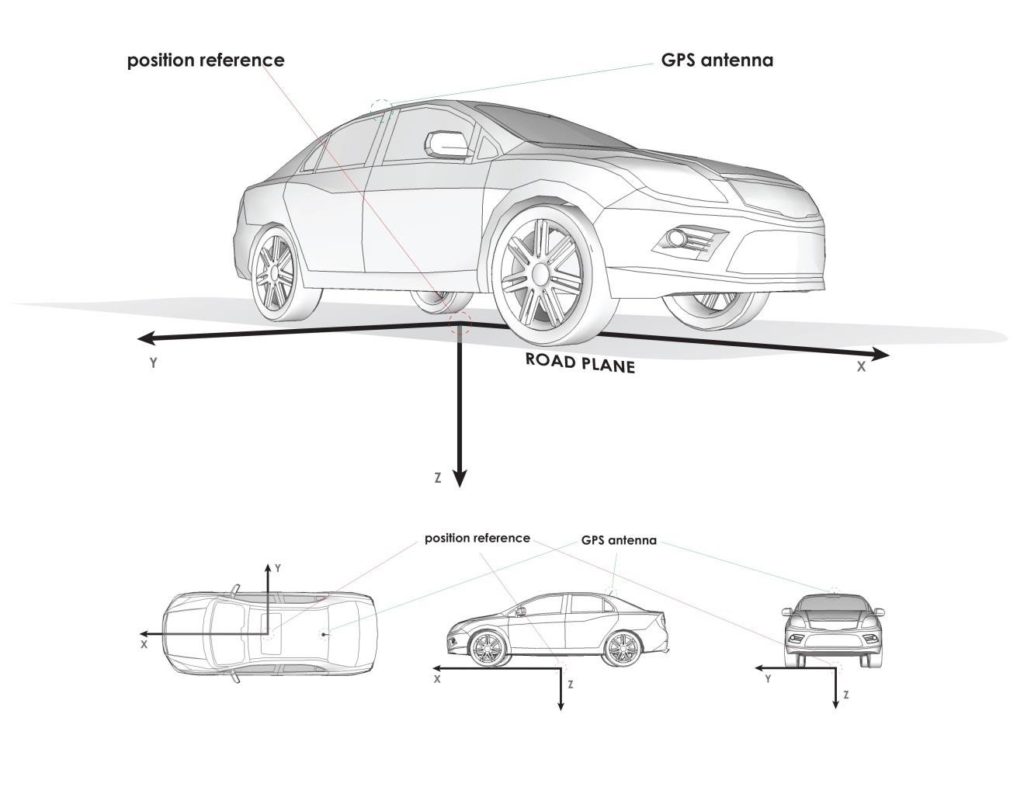
NHTSA describes possible V2V calibration considerations, role for aftermarket production, installation
By onEducation | Legal | Market Trends | Repair Operations | Technology
Even older cars could still be equipped with vehicle-to-vehicle technology fairly easily, the NHTSA says, suggesting that auto body shops might not necessarily be able to count on 20 years of existing older cars to produce crash volume.
On the plus side, the National Highway Traffic Safety Administration sees a role for the aftermarket in installing such crash-prevention devices — a potential, if ironic, revenue stream for some collision repairers. It also described concepts and processes for installing and partly calibrating the technology — something that’ll have to be done presumably on both aftermarket and OEM vehicle-to-vehicle technology on future collision repairs.
V2V technology allows cars to “talk” to each other and warn each other’s A.I. and human drivers of a potential collision. Pair these items with automatic safety systems like lane-keeping or automatic braking, which hedge against the human error that causes most crashes, and frequency takes a big hit.
“NHTSA estimates that safety applications enabled by V2V and V2I (vehicle-to-infrastructure, such as traffic lights) could eliminate or mitigate the severity of up to 80 percent of non-impaired crashes, including crashes at intersections or while changing lanes,” the National Highway Traffic Safety Administration wrote in a news release Tuesday. The agency is proposing mandating the technology.
Under the NHTSA’s proposed rule, 100 percent of new vehicles must have V2V devices by 2023. By the 2022 model year, all new cars will voluntarily deliver automatic braking standard. The average age of a car in a repairable crash is about 7 years. So by 2030, collision repairers are really feeling the pinch.
However, there’s still millions of deaf, mute, non-V2V cars out there, right? They’ll crash into stuff and yield some work through about 2040 or so.
“NHTSA typically assumes that the maximum life span of a light vehicle is 39 years,” the agency wrote in its extensive discussion of its proposed rule. “We would anticipate that the vast majority of the light vehicle fleet in the U.S. will be completely replaced in less than 20 years, and they will be capable of V2V communications.”

But the agency anticipates third-party manufacturers will see enough demand to consider selling V2V options during that “relatively small window of time to sell aftermarket devices.”
This presumes consumers would buy the aftermarket technology, the simplest version of which would cost around $102 and might yield more crashes than more advanced third-party tiers costing around $278 and $400. (The NHTSA describes the cheapo aftermarket option as a beacon transmitting “I’m here, don’t hit me” to nearby cars but not receiving anything.)
However, insurance discounts could spur sales, just as premium reductions might incentivize purchases of LoJack or car alarms. The NHTSA also noted that some consumers might buy the technology for other benefits besides safety, and seemed confident in general that V2V would find its way onto some existing cars.
“Based on market study research, the agency believes that the aftermarket device industry will move quickly (within one year) after the issuance of the final rule to develop and market V2V communications devices that support safety applications as well as mobility, environmental, and other applications,” the NHTSA wrote. “While these aftermarket devices will support V2V, they will also enable more fee-based services such as mobility applications and data and communications suites to be marketed to device owners. While safety is important to consumers, the other applications offered by these devices may be potentially more attractive to the consumer. The agency believes that there will be a market for these aftermarket devices; however, it will be driven by the totality of features offered by these devices that directly impact the consumers’ time spent in their vehicles, as well as by device cost.”
The less advanced aftermarket options might still yield crashes, of course.
Whether OEM or aftermarket, the technology would have to be installed — and the ability of third-parties to accomplish this could theoretically lead to aftermarket versions beating some OEMs in terms of adoption rates.

“Additionally, based on research from the Safety Pilot Model Deployment and additional market research, we believe the aftermarket industry is capable of producing V2V communications devices that can meet the proposed performance requirements and could be installed by a qualified installer, if needed,” the agency wrote. “These aftermarket devices do not need to be connected to the vehicle controller area network vehicle bus; however, an external GPS and V2V antenna will need to be installed as well as a connection to the in-vehicle power. Therefore, the agency expects that specially-trained installers should be able to install these devices in a similar manner to other devices such OnStar FMV, which is installed at major electronics retailers as well as at car dealerships. Therefore, these devices could deploy faster than OEM integrated as they do not require an OEM to integrate them into their vehicle build and testing processes. For these reasons, the agency believes it is technically possible that these devices could be available on the market within one to two years after this proposed FMVSS is finalized.”
However, collision repairers or other installers shouldn’t take this process likely. A screwup in installation or calibration could compromise the important safety feature and jeopardize more vehicles besides a customer’s car.
“The proposed requirements for any V2V devices recognize that, as DOT discovered in the Safety Pilot Model Deployment, installation can significantly impact how devices perform,” the NHTSA wrote. “The agency believes there is high probability that a certified device installer could complete the installation for aftermarket safety devices. It is imperative that all V2V components be properly installed to ensure that an aftermarket device functions as intended. Whereas some vehicle owners may choose to replace their own brakes or install other components on their vehicles themselves, installation requirements for aftermarket V2V devices may not be conducive to a do-it-yourself approach. Improper installation of a GPS antenna has the potential to affect the proper population of BSM data elements. Faulty position data from a transmitting vehicle can result in false warnings, improperly timed warnings, etc. Moreover, an improperly installed aftermarket device may put all other V2V-equipped vehicles it encounters at risk until the given vehicle stops communicating, or until its messages are rejected for misbehavior. (Emphasis ours.)
“The agency seeks comment on the potential need for certification of aftermarket V2V device installations. If so, please provide any potential recommendations of appropriate retail outlets, the certification mechanisms, and authorizers (vehicle manufacturers, device manufacturers, device retailers, others) that should be employed. Conversely, do commenters believe that future available technology may allow consumers to self-install V2V devices such as web-based tools, or other potential methods, that could verify accuracy of an installation? Research supporting this possibility would be very helpful.”
Presumably, some sort of calibration will be necessary of an OEM or aftermarket V2V based on the some of the NHTSA’s precise description of a potential baseline configuration.
In a nutshell, the NHTSA is considering saying the car needs to be accurate within 1.5 meters of longitude and latitude and 3 meters of height, key off a datum point derived from a flat road, and be accurate to 1 kph/0.62 mph of speed. Some of this will probably be the manufacturer and GPS industry’s problem, some of it might be yours.
Our proposal is to define the vehicle reference point as the theoretical point projected on the surface of the roadway that is in the center of a rectangle oriented about the vehicle’s axis of symmetry front-to-back. This rectangle encompasses the farthest forward and rearward points and side-to-side points on the vehicle, including original equipment such as outside side view mirrors on the surface of the World Geodetic System-84 (WGS-84) ellipsoid (see Figure III-8). The position reference is obtained from measurements taken when the vehicle is situated on level ground/roadway, i.e. where there is no difference in grade in any direction and all tires contact the ground/roadway evenly. This position provides the BSM position reference of the center of the vehicle along all axes that can be used to determine the outer perimeter of the vehicle in relation to vehicle movement. The position reference is also used to configure the GPS antenna if the antenna cannot be placed at the vehicle’s center point. …

Longitude and latitude position would require that vehicles report a position that is within 1.5 m of their actual position at a Horizontal Dilution of Precision (HDOP)141 less than or equal to 1.5 within the one sigma absolute error. For the 2D location we tentatively believe that 1.5 m is appropriate because it is half of the width of a lane of traffic. Therefore, if vehicles provide position data within this level of accuracy, safety applications should be able to determine whether another vehicle is within its lane of travel. …
Due to the different situations in which elevation is relevant, vehicles would be required to report elevation in the basic safety message with an accuracy of three meters—rather than 1.5. In terms of elevation, our tentative belief is that the information does not need to be as exact as the longitude and latitude location. Our proposal currently uses three meters (approximately 10 feet) because it provides sufficient distance to distinguish between a vehicle crossing an overpass versus those that are on the same level as the vehicle with a safety application. …
We are proposing that vehicles report their speed in the basic safety message accurate to within 0.28 m/s (1 kph). We tentatively believe that this is the appropriate accuracy for the Speed data element based on the agency’s experience in the Safety Pilot Model Deployment, where systems reporting speed information accurate to within 1 kph effectively supported the tested safety applications. We are not aware of any instances during the Model Deployment where an application warned at the incorrect time (i.e., false positive) or failed to warn (i.e., false negative) due to any inaccuracies in the Speed data element.
The NHTSA also proposes a method of testing to make sure the V2V system will work quickly after a driver starts the car. One wonders if repairers will be tasked with the same work during an installation or if this is more of a factory-level thing:
In summary, NHTSA is proposing to require that, after a conditioning procedure, vehicles begin transmitting basic safety messages with the required content and at the required frequency within 2.0 seconds after the driver puts the vehicle into the forward or reverse gear. The conditioning procedure would specify that the vehicle is under open sky conditions as in our test procedure for evaluating the content of the basic safety message. Then the procedure would specify that the test technician:
- drives the vehicle in any heading at any speed for five minutes;
- stops the vehicle and deactivates the vehicle for any amount of time between 30 minutes to an hour;
- checks to ensure that the V2V system components are in a powered off state;
- opens the driver’s door to any width,
- closes the driver’s door;
- activates the starting system using the key; and
- selects any gear (forward or reverse) at any time not less than 4.0 seconds and not more than 6.0 seconds after the driver’s door is opened. The driver door is open when the edge of the driver’s door opposite of the door’s hinge is no longer flush with the exterior body panel.
One final point worth remembering as well for shops and aftermarket manufacturers. Know you’re doing it wrong or taking the vehicle out of compliance, and you’re breaking the law.
“In fact, Congress expressly prohibits manufacturers, distributors, dealers, and motor vehicle repair businesses from knowingly making inoperative any part of a device or element of design installed on or in a motor vehicle in compliance with an applicable motor vehicle safety standard prescribed by NHTSA,” the NHTSA states.
Be heard: Public comment can shortly be left on www.regulations.gov for docket NHTSA-2016-0126.
More information:
National Highway Traffic Safety Administration, Dec. 13, 2016
NHTSA notice of proposed V2V rulemaking
NHTSA, Dec. 13, 2016
Images:
An example of how vehicle-to-vehicle communication could prevent crashes. (Government Accountability Office via NHTSA)
Examples of how vehicle-to-vehicle communication could prevent crashes. (Government Accountability Office, Crash Avoidance Metrics Partnership via NHTSA)
Elements of vehicle-to-vehicle technology. (Government Accountability Office, Crash Avoidance Metrics Partnership via NHTSA)
A National Highway Traffic Safety Administration diagram related to proposed V2V configuration on vehicles. (Provided by NHTSA)
